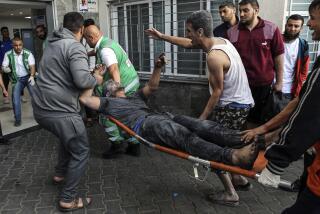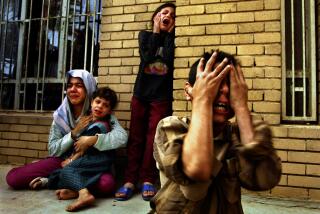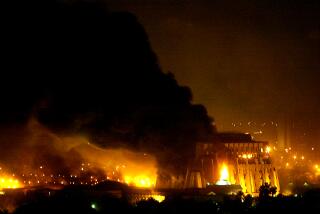Fog of War Triggered Iraq’s Attack on Khafji : Tactics: Stripped of sophisticated intelligence-gathering capability, Hussein’s troops are forced to do it the hard way.
- Share via
Groping in the dark. That’s the best way to explain what happened along the Saudi-Kuwaiti border this week. Although Iraq’s Saddam Hussein boasted that the attack was “wiping out the renegade invaders,” as a “prelude to the liberation of the entire Saudi kingdom” the real reason was much more mundane. The Iraqi army, bereft of sophisticated electronic intelligence-gathering and targeting capabilities, was trying to penetrate the fog of war with primitive methods as old as warfare itself.
“Reconnaissance in force,” was how it was labeled by Gen. H. Norman Schwarzkopf, the U.S. commander in the Gulf. The four enemy incursions at Khafji and eastward across a 25-mile stretch of border no doubt had several objectives. But their primary goal was intelligence-gathering.
Although Hussein paid a heavy price--early reports listed his losses at 42 tanks, 35 other vehicles and three short-range Frog ground-to-ground missiles--he now knows how coalition forces in that sector are currently disposed. He knows where they have entrenchments and artillery. He has a rough idea of the firepower at their disposal.
The reason he had to do it the hard way is that he lacks the ability to get it through other means. What technical ability he did possess was neutralized in the first phases of the allied air bombardment. “The simple fact of the matter is that now, every time an Iraqi airplane takes off the ground,” Schwarzkopf said, “it’s running away.”
Thus, Hussein not only is crippled, but he’s blinded, for he has no capability for aerial reconnaissance of the battlefield. He cannot fly over allied positions and take pictures. And he cannot do it electronically, either, for all his AWACS-type aircraft capable of such intelligence-gathering also have been lost. And with U.S. “smart” missiles and bombs homing in on his radar signals, his capability for target acquisition--that is, locating allied artillery positions and the like--has been rendered ineffective because he is loathe to turn his radar on to track incoming allied fire.
That means he has to resort to ground reconnaissance to learn the allied order of battle. Small recon patrols try to feel out the location of allied emplacements. Once the general outline of the battle lines is established, probing patrols force the allies to defend themselves, revealing their gun locations and defensive preparations.
Allied forces, in the meantime, are conducting an entirely different reconnaissance in force. Satellites orbiting high over Iraq not only monitor movement on the ground, they eavesdrop on enemy signal communications.
AWACS aircraft monitor Iraqi airspace, giving early warning of any enemy air activity. Aircraft fly over enemy lines, taking detailed photographs of their battle positions. And at the front, Firefinder radar reaches out more than 18 miles behind Iraqi lines to spot enemy artillery projectiles in flight and mathematically backtrack their trajectory. The location of enemy guns is pinpointed and relayed to allied artillery positions so rapidly that counter-battery fire can be on the way even before the enemy shells hit the ground.
Using electronic means, the allies can penetrate the fog of war without having to resort to ground probes to feel out the enemy and risk the kind of casualties that Saddam Hussein has suffered in his attacks. But worse for Hussein is that, even though it has been penetrated, the fog of war is still there. With his patrols and his reconnaissance in force, he cannot know the complete details of allied dispositions.
At the same time, even with their sophisticated intelligence means, the U.S. forces cannot totally guard against tactical surprise. Initial reports were that the Iraqi attack was detected almost as soon as it was launched and was assaulted by helicopters, AC-130 fixed-wing gunships and artillery. Still, it was the soldier on the ground who finally halted and turned back the enemy advance.
Thus was answered perhaps the most important question of all: Would coalition forces fight, or would they run away? The answer to that question might seem obvious to those who have never been under enemy fire. But what happens when that first round is fired is a question for which the answer never can be taken for granted. All the training in the world can never quite prepare a soldier for the terrible realization that this “live-fire exercise” is for real, that someone out there is actually trying to kill him.
For the Arab soldiers from Saudi Arabia and Qatar who retook Khafji, and for the U.S. Marines who took part in those border battles, the test has come and gone. The answer is now in, and it is not one Saddam Hussein wanted to hear. Arabs will indeed fight Arabs to liberate their Arab brethren. And the U.S. Marines, as always, will stand to their guns.
But the allies also received some answers that some among them may not have wanted to hear. They have been disabused of the notion that the enemy army would crumble under allied bombing and simply throw up its arms and quit. As Gen. Schwarzkopf observed, the Iraqi attack proved, if nothing else, that “they certainly have a lot of fight left in them.”
“You can never do too much reconnaissance,” said Gen. George S. Patton Jr.
You can count on it that there will be many more such enemy probes before this war comes to an end.
More to Read
Sign up for Essential California
The most important California stories and recommendations in your inbox every morning.
You may occasionally receive promotional content from the Los Angeles Times.













